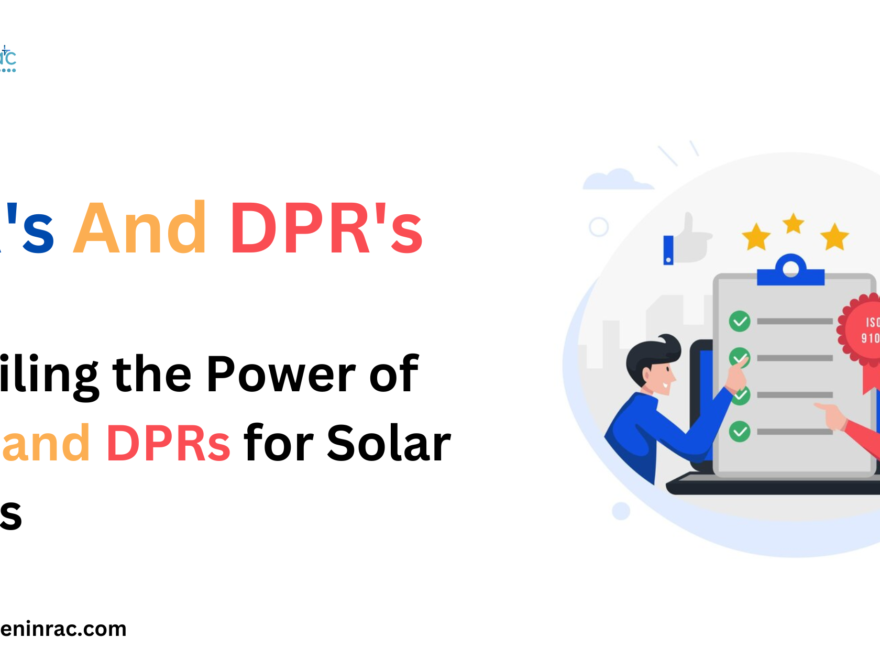Solar energy is increasingly becoming a focal point in the global quest for sustainable energy sources. As interest in solar power projects grows, so does the need for thorough planning and assessment. Two crucial documents play a pivotal role in the development of solar plants: Pre-Feasibility Reports (PFRs) and Detailed Project Reports (DPRs). In this comprehensive guide, we’ll delve into the significance of PFRs and DPRs, their components, and why they are indispensable for successful solar plant ventures.
Understanding Pre-Feasibility Reports (PFRs)
PFRs serve as the preliminary assessment of the viability of a solar power project. They provide an initial overview of the project’s feasibility, highlighting key aspects such as location suitability, resource availability, and potential challenges. Let’s break down the components of a typical PFR:
Location Suitability Analysis
Determining the optimal location for a solar plant is paramount for its success. PFRs include detailed analyses of various locations, considering factors such as solar irradiance, land availability, proximity to transmission infrastructure, and environmental considerations.
Resource Assessment
Solar power generation relies on the availability of sunlight. PFRs assess solar irradiance levels in different locations throughout the year to gauge the solar energy potential of the proposed site. This analysis helps in estimating the energy output and economic viability of the project.
Technical Feasibility
PFRs also evaluate the technical aspects of the project, including the choice of solar technology, system design, and integration with the grid. This assessment ensures that the proposed solar plant aligns with technical standards and can be implemented efficiently.
Financial Viability
Financial feasibility is a critical aspect of any solar power project. PFRs include preliminary cost estimates, revenue projections, and financial indicators such as the levelized cost of electricity (LCOE) to assess the project’s economic viability and attractiveness to investors.
H2: Delving into Detailed Project Reports (DPRs)
Once the feasibility of a solar power project is established through PFRs, the next step is to develop a Detailed Project Report (DPR). DPRs provide a comprehensive roadmap for the implementation of the project, offering detailed insights into various aspects:
Project Design and Engineering
DPRs delve into the specifics of the solar plant design, including the layout of solar panels, mounting structures, inverters, and other components. Engineering analyses ensure that the design meets performance requirements, maximizes energy output, and adheres to relevant standards and regulations.
Procurement and Construction Plan
DPRs outline the procurement strategy for acquiring materials, equipment, and services required for the solar plant construction. Additionally, they provide a detailed construction plan, including timelines, resource allocation, and quality assurance measures to ensure timely and cost-effective project execution.
Environmental and Social Impact Assessment
Solar power projects must undergo thorough environmental and social impact assessments to identify potential risks and mitigate adverse effects on the surrounding ecosystem and communities. DPRs include detailed assessments and mitigation measures to ensure compliance with regulatory requirements and sustainability standards.
Financial Analysis and Funding Plan
Building upon the financial insights from the PFR, DPRs offer a more detailed financial analysis, including updated cost estimates, revenue forecasts, and cash flow projections. A robust funding plan outlines the sources of financing, such as equity, debt, grants, or subsidies, to support the project’s implementation.
The Interplay Between PFRs and DPRs
While PFRs provide an initial assessment of a solar power project’s feasibility, DPRs offer a deeper dive into the technical, financial, and operational aspects, laying the groundwork for successful project implementation. The interplay between these two reports is crucial for ensuring informed decision-making and minimizing risks throughout the project lifecycle.
Iterative Process
It’s important to note that the development of PFRs and DPRs is often an iterative process. As new information becomes available or project requirements evolve, these reports may need to be updated and refined to reflect the latest insights and ensure alignment with project goals and stakeholders’ expectations.
Stakeholder Engagement
Both PFRs and DPRs involve active stakeholder engagement to gather input, address concerns, and garner support for the project. Collaboration with government agencies, local communities, investors, and other stakeholders is essential for securing permits, approvals, and financing necessary for project implementation.
Conclusion
In conclusion, Pre-Feasibility Reports (PFRs) and Detailed Project Reports (DPRs) are indispensable tools for the development of solar power projects. While PFRs assess the initial feasibility and viability of the project, DPRs provide a detailed roadmap for its implementation, covering technical, financial, environmental, and social aspects. By meticulously preparing and leveraging these reports, stakeholders can navigate the complexities of solar project development with confidence, ultimately contributing to the growth of renewable energy and sustainability efforts worldwide.

